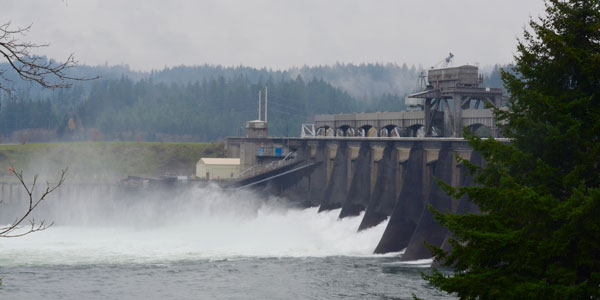By Robert Mullin
FERC last week clarified that it would allow CAISO contracts for transferred frequency response service to include a provision recognizing that counterparties could fulfill the agreements based on an annual measure of performance rather than a case-by-case accounting of responses to frequency disturbance events.
In the same order, the commission rejected a rehearing request by the Western Power Trading Forum (WPTF) and NRG Energy that challenged the fairness of the process by which the contracts were procured (ER16-1483).

FERC’s clarification on CAISO’s transferred frequency response contract terms clears the way for the ISO’s agreements with the Bonneville Power Administration and Seattle City Light. | © RTO Insider
FERC last month approved ISO frequency response contracts with the Bonneville Power Authority and Seattle City Light, both of which were contingent on the outcome of the commission’s clarification. (See FERC Accepts CAISO Contracts for Imported Frequency Response.)
CAISO filed a request for clarification after the commission last September approved the ISO’s Tariff authority to procure transferred frequency response from another balancing authority area (BAA). The ISO sought the authority in an effort to comply with NERC reliability standard BAL-003-1.1, which requires all grid operators to carry enough capability to respond to a disturbance.
In that order, the commission stated that the CAISO contracts must result in a counterparty actually providing the ISO with frequency response service and not simply be “an arrangement for counterparties to transfer a regulatory obligation by means of bookkeeping entries.”
The ISO sought more clarity from the commission on that point, contending that contract counterparties could interpret the decision as requiring them to have a net actual interchange measure in response to every single frequency disturbance event.
“Such a requirement would make it virtually impossible for the CAISO to contract for transferred frequency response quantities because balancing authorities cannot assure such a measure in response to every disturbance event,” the ISO said in its request.
CAISO contended that the transferred frequency response performance of a counterparty BAA should not be tied to each disturbance because compliance with the NERC standard itself is not based on performance in connection with a single event.
Powerex, which also sought clarification on the order, backed the ISO, holding that a BAA is able to meet the BAL-003-1.1 obligation through a median measurement of performance across all identified disturbance events during a compliance year.
The commission agreed with those arguments, acknowledging that “NERC determined that the degree of variability in observed frequency response performance values limits the usefulness of imposing a single event-based compliance measure” on BAAs.
“In directing CAISO to revise its tariff to state that it ‘cannot claim on a compliance form that it has received, or that the counterparty has transferred, more frequency response performance than the counterparty has produced,’ the commission did not intend to require BAs to achieve a specific net actual interchange measure for each disturbance event to support transferred frequency response contracts,” the commission said.
The commission rejected the contention by WPTF and NRG that it acted “arbitrarily and capriciously” in determining that the product category of transferred frequency response — the notion of which was introduced by the BAL-003-1.1 standard — consists of both compliance reporting rights and the physical delivery of primary frequency response service.
Under the contracts, the commission noted, CAISO would be acquiring both the reporting rights and the frequency response service, which would act as an “insurance policy” for the ISO in meeting its obligation.
“Contrary to NRG and WPTF’s characterization of the Sept. 16 order as stating that ‘generators are incapable of bidding to provide a physical product to the CAISO,’ the Sept. 16 order determined that generators and BAs are differently situated due to the unique nature of BAs’ BAL-003-1.1 compliance obligations,” the commission said.
The commission said that NRG and WPTF’s argument that BAAs might be circumventing competition provisions set out in FERC Order 888 by bundling service from their generators into transferred frequency response was beyond the scope of the proceeding.
FERC also declined to entertain a WPTF proposal to increase the size of the frequency response market by allowing generators to compete, saying that the issue before the commission was to determine whether the proposed CAISO contracts are just and reasonable “and not whether the proposal is more or less reasonable than other proposed alternatives.”
CAISO late last year launched a stakeholder initiative to develop a market mechanism for acquiring primary frequency response service. (See CAISO Seeks Primary Frequency Response Market.)




